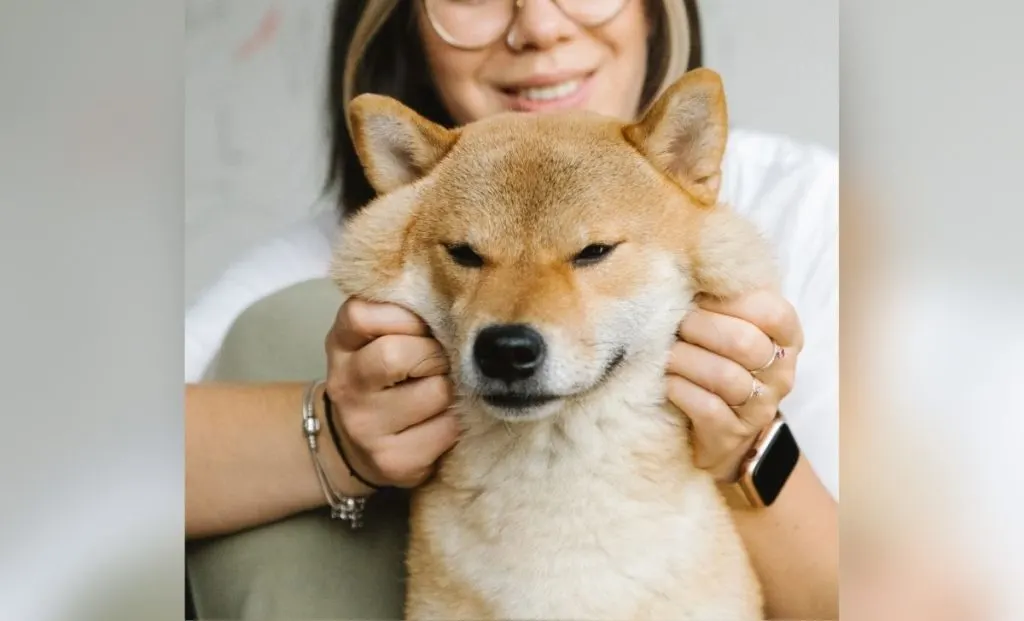So, you’re interested in the gorgeous and loyal Akita puppies? Well, I can’t blame you!
Akita dogs are not for the faint of heart; they are quite a problematic breed to own, but they make fantastic additions to homes that know how to care for them.
If you have already selected the breed but need to decide between the everlasting Akita male vs female question, there are some additional things you can consider.
This article will discuss an overview of what an Akita is like as a whole and the differences between the two sexes.
Hopefully, you can use this as a road map to lead you to your newest family member.
| Average height | Average weight | Average lifespan | |
| Adult female Akita Inu | 24 – 26 inches | 70 – 100 pounds | 10 – 12 years |
| Adult male Akita Inu | 26 – 28 inches | 100 – 120 pounds | 10 – 12 years |
The Akita Breed 101

The Akita is a visually stunning, remarkably protective Japanese dog breed that needs a strong, determined pack leader.
There are two types of Akita: American Akita and Japanese Akita Inu.
The Japanese Akita must be one of these colors: red with creamy white underside, solid white, or brindle on top with creamy white underside.
You can find Japanese Akitas in the US, but you’ll need to search hard.
The native Japanese Akita is smaller than the American version, has a foxier head, is lighter on its feet, and only comes in three colors: solid white, red and white, or brindle and white. Japanese Akitas never have a black mask.
The American Akita is more prominent (the US always seems to think that everything, including dog breeds, should be more massive), more muscular, and comes in lots of colors: brindle, white, fawn, black, pinto (white with patches), and others.
Unlike Japanese Akitas, American Akitas frequently have a black mask. Now that we know these two types’ differences let us get into the fun stuff!
In this article, we’ll discuss what owning a male and female Akita is like. Since this is a particularly challenging dog breed, we want to touch very strongly on the negative aspects so that you can make the best decision for your living situation.
These are incredible to own as they are remarkably intelligent, intensely faithful companions. However, they are only compatible with certain lifestyles where they can have harmonious relationships. Let’s get into it.
Male And Female Akita Overview

Male Akitas are far more substantial in size than their female counterparts, but what other differences can you expect?
However, many things about female Akita will mirror their male counterparts.
But that doesn’t mean that they are created equal. Owning a female Akita differs significantly from owning a male; we will tell you why.
Male Akita Personality
Male Akitas are incredibly friendly as puppies.
They will be very social, outgoing, and playful. This can be seriously misleading for some owners. As your Akita grows, some of the aloofness and territorial nature begin to emerge.
Male Akitas tend to be very dominant, challenging your authority and any other dogs in the home. Being an experienced dog owner who can maintain a firm hand when training is essential.
The male Akita must learn early on how the household hierarchy works. If you let them, they will be very bossy, demanding, and even disobedient. However, they will respect the head of the household.
While highly loyal and protective of family, they don’t share the same sentiment towards strangers.
Male Akitas tend to be a little more aggressive and untrusting of strangers, as well as their female counterparts, so neither gender is crazy about outsiders.
While males are very dominant, they tend to have more tolerance of the same sex than their female counterparts.
Female Akita Personality
Female Akitas make lovely additions to suitable homes. When they are puppies, they tend to be very playful and lovable towards all people they see. Their aloofness starts to show as they age, and they intensely dislike strangers.
However, many female Akitas have a powerful maternal instinct, even with human children. So, they tend to carry an extreme loyalty and make it their mission to protect and devote themselves to their owners.
Female Akitas tend to be less stubborn than their male counterparts but can have their fair share of downfalls. For example, if you have another female in the home or plan to get another female dog, you might want to get a male instead.
Female Akitas are notoriously same-sex aggressive. They want to rule the roost, and they will be complicated to get along with and sometimes violent with other females in the home.
Often, owners in this predicament must look at severe measures, including rehoming one of the dogs to create peace.
To be sure, it’s best not even to try the female with female combination.
Training Akitas – Male

Training a male Akita is not for the faint of heart.
These dogs are incredibly challenging to manage as they love to test authority at every turn. Early training is crucial for the success and future relationship between the two of you.
Your Akita must learn to respect your authority and your boundaries. If you let an Akita rule the roost, they certainly will do so. Males tend to put up more of a power struggle than their female counterparts.
Even experienced dog owners often find maintaining an Akita’s temperament challenging. They usually turn to the help of breed experts and professionals to receive proper obedience training and learn appropriate manners.
Early socialization is also crucial for Akitas during their training phases.
They should be exposed to as many different situations as possible to create a well-rounded personality. As your Akita matures, taking them around other dogs can be challenging.
Each individual dog will be different, but they almost always require pervasive training and often professional intervention. An inappropriately trained Akita can be hard to manage and even dangerous in some situations.
Training Akitas – Female
Since female Akitas tend to be less stubborn and rigid than their male counterparts, training is often more easier in specific categories.
For example, female Akitas tend to be more eager to please. They tend to be more attentive during training, and you can also typically start a lot earlier than with males.
It is not because female Akitas are necessarily more intelligent than males; it’s simply because you can keep their attention at a younger age. Male Akitas are more challenging to convince during times of intense focus.
The females require an experienced owner to guide them. If you need more confidence in your abilities, we still highly recommend receiving professional training for your female Akita.
After all, they pose different challenges than their male counterparts, and getting a professional to guide you can be helpful. However, overall, they should give you less trouble than this area of care.
Health & Care Of The Boys
Akitas are generally prone to health problems, but males are more likely to suffer from bone, hip, and joint problems.
Some issues like hip dysplasia and bloat are also linked to their size. They are prone to prostate cancer, but their chances of getting this can be lessened with neutering, which you can talk over with your vet.
It can feel like you have less control over caring for your Akita regarding genetics and inherited diseases. However, this is why keeping up with your vet visits is so important.
Many problems can be managed with the proper treatment and care.
Health & Care Of The Girls

Females are less prone to the health problems plaguing their male counterparts.
Still, they are prone to significant diseases, like cancer, auto-immune diseases, sebaceous adenitis, glaucoma, hypothyroidism, and progressive retinal atrophy, which threaten both genders.
It’s important to note that just because a breed is more likely to develop a health problem doesn’t mean they will get everything they’re vulnerable to.
Breeding Males
As we’ve mentioned, neutering can improve your dog’s health.
However, it can also change their behavior. Neutering a male dog involves removing the testicles, which can cause subtle changes in behavior.
Of course, all dogs are different, and there is some debate about how much neutering affects a male dog’s behavior. However, some agree that some behaviors can be linked to not neutering your dog, such as:
- Aggression
- Increased libido
- Increased self-confidence (increased risk-taking and reduced fear response)
- Roaming (looking for females in heat to mate with)
- Sexual behaviors (like humping and mounting objects/furniture)
- Territorial behavior
It’s advised that unless you’re planning to breed your Akita, it’s a good idea to neuter him.
Generally, neutering is considered a relatively minor procedure and cheaper than spaying a female.
Breeding Females
There are significant benefits to spaying your female Akita, which means you should consider getting her spayed before her first heat unless you’re planning to breed her.
This typically occurs when a dog is 6 to 15 months old.
Not only does spaying prevent unwanted pregnancy, but it can also decrease the incidence of breast tumors and uterine infections.
And The Winner Is…
Now that you have a little more insight into each sex let’s get down to brass tacks.
Here’s a side-by-side comparison of all the pros and cons of each and which wins each category. The verdict: it depends on your lifestyle and preference!
More Substantial: Males
The male certainly wins this category if you’re looking for the more prominent and scarier of the two.
Males are always at least 10 pounds heavier than their female counterparts, are certainly bulkier, and have heavier muscle tone.
So, if you’re looking for a very robust, intimidating-looking dog, the male wins this category hand over fist.
Easier To Train: Females
Even though males and females face challenges in training, females find it more manageable.
Males have a decisive dominance factor that can make it extremely rough for first-time owners.
So, if you are looking for the easiest to train, we have to recommend the female in this particular category.
However, remember that females can be complicated in their ways as well.
Aggression Problems: Both
Any Akita owner will tell you that one of the most challenging aspects of having these beautiful dogs is their inclination towards aggression.
Males are more aggressive towards other pets and strangers that don’t reside in the home.
Conversely, females tend to be a little more aloof with strangers and aggressive towards dogs of the same sex.
So, some aggressive factors are in play on both ends of this equation. If you already have a female in the home, we highly suggest getting a male instead.
However, if this category doesn’t apply to you, understand that they both will come with their share of aggressive tendencies that must be curbed with early socialization and proper training.
Loyalty: Both
Something positive about Akitas is that they are loyal to a fault.
These dogs will imprint on their families and remain completely devoted as long as they live.
They unquestionably come with their fair share of challenges that take a unique living situation to manage, but they will give you love and affection until their dying day.
Which Gender Is Right For You?
Hopefully, after reading this, you understand the challenges and benefits of owning a male and female Akita.
While both can be incredibly unique dogs to have in your care, they come with their quirks.
We want to stress again that aggression is a huge problem with this breed.
Females tend to dislike living with other females. And both males and females can dislike strangers and strange dogs.
Because of their prey drive, they are often incompatible with cats and smaller pets.
So before choosing a male or female, ensure your experience level and living situation is compatible with this breed.

Nandina has been a lifelong dog owner and enthusiast. She shared her home with multiple breeds, including Giant Schnauzers, Cane Corsos, and Huskies. Currently, she is raising a three-year-old rescue and a working-line German Shepherd puppy.
Actively engaged in IGP dog sports for two years, Nandina is a certified instructor for basic obedience and socialization. She works as a trainer in her local dog sports club, and in her spare time, she handicrafts biothane gear for dogs.
